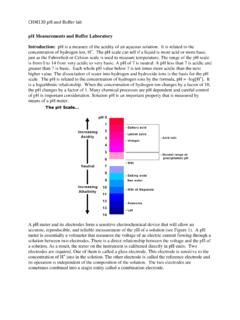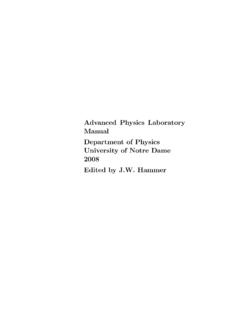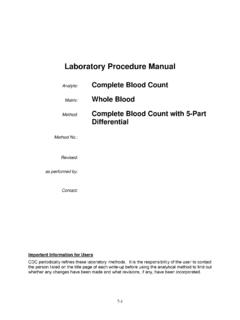Transcription of Science 7–12 (236) Preparation Manual
1 Texas Examinations of Educator Standards . (TExES ) Program Preparation Manual Science 7 12 (236). Copyright 2018 by Texas Education Agency (TEA). All rights reserved. The Texas Education Agency logo and TEA are registered trademarks of Texas Education Agency. Texas Examinations of Educator Standards, TExES and the TExES. logo are trademarks of Texas Education Agency. The Texas Education Agency and Pearson do not discriminate on the basis of race, color, national origin, sex, religion, age, or disability in the administration of the testing program or the provision of related services. Table of Contents Table of Contents .. 2. About The Test .. 4. The Domains .. 5. The Standards .. 6. Domains and Competencies .. 8. Domain I Scientific Inquiry and Processes .. 8. Domain II Physics .. 10. Domain III Chemistry .. 14. Domain IV Cell Structure and Processes .. 18. Domain V Heredity and Evolution of 19.
2 Domain VI Diversity of Life .. 21. Domain VII Interdependence of Life and Environmental Systems .. 23. Domain VIII Earth's History and the Structure and Function of Earth Systems .. 25. Domain IX Components and Properties of the Solar System and the Universe .. 29. Domain X Science Learning, Instruction and Assessment .. 31. Approaches to Answering Multiple-Choice Questions .. 34. How to Approach Unfamiliar Question Formats .. 35. Question 36. Single Questions .. 36. Clustered Questions .. 39. Multiple-Choice Practice Questions .. 46. Answer Key and Rationales .. 68. Study Plan 91. NOTE: After clicking on a link, right click and select Previous View to go back to original text. TExES Science 7 12 (236) 2. Preparation Resources .. 92. NOTE: After clicking on a link, right click and select Previous View to go back to original text. TExES Science 7 12 (236) 3. About The Test Test Name Science 7 12.
3 Test Code 236. Time 5 hours Number of Questions 140 multiple-choice questions Format Computer-administered test (CAT). The TExES Science 7 12 (236) test is designed to assess whether a test taker has the requisite knowledge and skills that an entry-level educator in this field in Texas public schools must possess. The 140 multiple-choice questions are based on the Science 7 12 test framework. Questions on this test range from grades 7 12. The test may contain questions that do not count toward the score. Your final scaled score will be based only on scored questions. NOTE: After clicking on a link, right click and select Previous View to go back to original text. TExES Science 7 12 (236) 4. The Domains Approx. Percentage Domain Domain Title of Test Standards Assessed I. Scientific Inquiry and Processes 10% Science 7 12 I III, VI VII, XI. II. Physics 20% Science 7 12 VIII.
4 III. Chemistry 20% Science 7 12 VIII. IV. Cell Structure and Processes 8% Science 7 12 IX. V. Heredity and Evolution of Life 8% Science 7 12 IX. VI. Diversity of Life 8% Science 7 12 IX. VII. Interdependence of Life and 6% Science 7 12 IX. Environmental Systems VIII. Earth's History and the 9% Science 7 12 X. Structure and Function of Earth Systems IX. Components and Properties of 6% Science 7 12 X. the Solar System and the Universe X. Science Learning, Instruction 5% Science 7 12 IV V. and Assessment NOTE: After clicking on a link, right click and select Previous View to go back to original text. TExES Science 7 12 (236) 5. The Standards Science 7 12 Standard I. The Science teacher manages classroom, field and laboratory activities to ensure the safety of all students and the ethical care and treatment of organisms and specimens. Science 7 12 Standard II. The Science teacher understands the correct use of tools, materials, equipment and technologies.
5 Science 7 12 Standard III. The Science teacher understands the process of scientific inquiry and its role in Science instruction. Science 7 12 Standard IV. The Science teacher has theoretical and practical knowledge about teaching Science and about how students learn Science . Science 7 12 Standard V. The Science teacher knows the varied and appropriate assessments and assessment practices to monitor Science learning. Science 7 12 Standard VI. The Science teacher understands the history and nature of Science . Science 7 12 Standard VII. The Science teacher understands how Science affects the daily lives of students and how Science interacts with and influences personal and societal decisions. Science 7 12 Standard VIII. The Science teacher knows and understands the Science content appropriate to teach the statewide curriculum (Texas Essential Knowledge and Skills [TEKS]) in physical Science .
6 Science 7 12 Standard IX. The Science teacher knows and understands the Science content appropriate to teach the statewide curriculum (Texas Essential Knowledge and Skills [TEKS]) in life Science . NOTE: After clicking on a link, right click and select Previous View to go back to original text. TExES Science 7 12 (236) 6. Science 7 12 Standard X. The Science teacher knows and understands the Science content appropriate to teach the statewide curriculum (Texas Essential Knowledge and Skills [TEKS]) in Earth and space Science . Science 7 12 Standard XI. The Science teacher knows unifying concepts and processes that are common to all sciences. NOTE: After clicking on a link, right click and select Previous View to go back to original text. TExES Science 7 12 (236) 7. Domains and Competencies The content covered by this test is organized into broad areas of content called domains.
7 Each domain covers one or more of the educator standards for this field. Within each domain, the content is further defined by a set of competencies. Each competency is composed of two major parts: The competency statement, which broadly defines what an entry-level educator in this field in Texas public schools should know and be able to do. The descriptive statements, which describe in greater detail the knowledge and skills eligible for testing. Domain I Scientific Inquiry and Processes Competency 001: The teacher understands how to select and manage learning activities to ensure the safety of all students and the correct use and care of organisms, natural resources, materials, equipment and technologies. The beginning teacher: A. Uses current sources of information about laboratory safety, including safety regulations and guidelines for the use of Science facilities. B.
8 Recognizes potential safety hazards in the laboratory and in the field and knows how to apply procedures, including basic first aid, for responding to accidents. C. Employs safe practices in planning, implementing and managing all instructional activities and designs, and implements rules and procedures to maintain a safe learning environment. D. Understands procedures for selecting, maintaining and safely using chemicals, tools, technologies, materials, specimens and equipment, including procedures for the recycling, reuse and conservation of laboratory resources and for the safe handling and ethical treatment of organisms. E. Knows how to use appropriate equipment and technology ( , Internet, spreadsheet, calculator) for gathering, organizing, displaying and communicating data in a variety of ways ( , charts, tables, graphs, diagrams, maps, satellite images, written reports, oral presentations).
9 F. Understands how to use a variety of tools, techniques and technology to gather, organize and analyze data, how to perform calculations and how to apply appropriate methods of statistical measures and analyses. NOTE: After clicking on a link, right click and select Previous View to go back to original text. TExES Science 7 12 (236) 8. G. Knows how to apply techniques to calibrate measuring devices and understands concepts of precision, accuracy and error with regard to reading and recording numerical data from scientific instruments ( , significant figures). H. Uses the International System of Units ( , metric system) and performs unit conversions within and across measurement systems. Competency 002: The teacher understands the nature of Science , the process of scientific inquiry and the unifying concepts that are common to all sciences. The beginning teacher: A. Understands the nature of Science , the relationship between Science and technology, the predictive power of Science and limitations to the scope of Science ( , the types of questions that Science can and cannot answer).
10 B. Knows the characteristics of various types of scientific investigations ( , descriptive studies, controlled experiments, comparative data analysis). and how and why scientists use different types of scientific investigations. C. Understands principles and procedures for designing and conducting a variety of scientific investigations with emphasis on inquiry-based investigations and how to communicate and defend scientific results. D. Understands how logical reasoning, verifiable observational and experimental evidence and peer review are used in the process of generating and evaluating scientific knowledge. E. Understands how to identify potential sources of error in an investigation, evaluate the validity of scientific data and develop and analyze different explanations for a given scientific result. F. Knows the characteristics and general features of systems; how properties and patterns of systems can be described in terms of space, time, energy and matter; and how system components and different systems interact.














